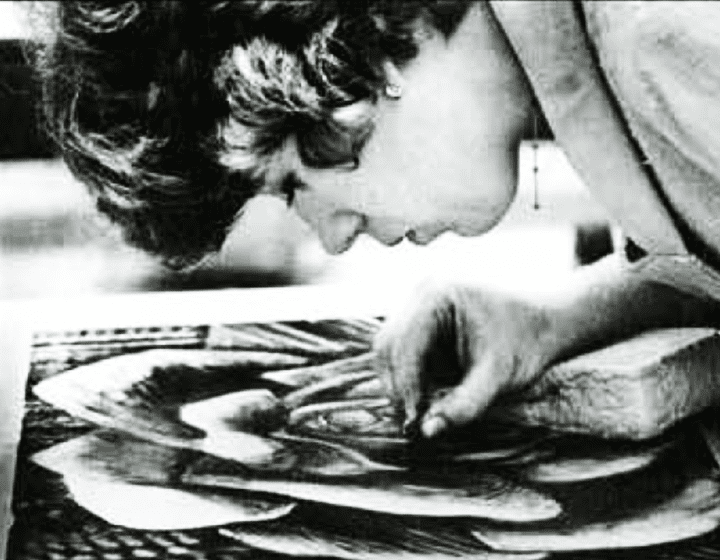
Before printing her next edition, steady-handed Marti Stratton scrapes her stone lightly to alter the shading in her drawing.
Artist’s Impression
Students hone creations in one of the “best lithography shops in the country
[ This article was originally published in the UTSA newsletter The Discourse in December 1976 ]
A stone may be an artist’s most sensitive medium. Students in classes taught by assistant professor of art Wayne Kimball are learning to use slabs of Bavarian limestone to produce fine lithographs. “Lithography has gained tremendous interest among artists and art students during the past 15 years,” says Kimball, whose lithography class was offered for the first time this fall [1976].
Each stone is extremely responsive, and the artist can capture a range of feelings on the stone canvas, Kimball relates. “Because of the unique individual characteristics of each of the stones, some of the earlier printers developed superstitions about demons inhabiting each stone,” says Kimball.
According to Kimball, lithography is the youngest of the major printmaking processes. It was developed in Europe in the 1790s as an alternative to printing with expensive copper plates. He notes that soon after lithography was invented, artists put it to use in the making of fine prints. “Many of the graphic masterpieces of the 19th and 20th centuries were lithographs,” he says.
He notes that lithography, whether used as a commercial printing method or employed as an art medium, is based on the principle that grease and water repel each other. “Whereas commercial offset printing emphasizes high-speed mechanical reproduction and volume output, fine art lithography still employs laborious hand processes,” says Kimball. “The richness of quality and subtle texture of hand-printed impressions cannot be duplicated by even the best mechanical reproduction techniques.”
In lithography, students draw directly on the stones using grease-based crayons or inks. The stones are 97% pure calcium carbonate and are quarried only in Bavaria. The drawings can be altered by scraping or scratching into the stone. When the drawing is complete the stone is treated with chemicals.
“This treatment is critical to the lithography process,” says Kimball. “The solutions chemically bond the image to the stone and form a highly water-receptive film over the entire nonimage area.”
When printing, the stone is dampened with water and inked. A sheet of 100% rag printing paper is then placed on the stone. The stone is covered with a protective backing and run through a hand-operated press, which supplies enough pressure to transfer the ink from the stone to the paper.
“We have an extremely good facility,” says Kimball. “It’s among the two or three best lithography shops in the country for students.” He adds that among the other outstanding and well-known student workshops are those housed at the University of New Mexico, the University of Wisconsin, and the Pratt Graphic Art Center.
“Our shop is well laid out with proper work and storage space,” says Kimball. “We have three presses, graining facilities for resurfacing stones, and appropriate drawing and processing areas.”
“Our 64 slabs range in size from 8 inches by 10 inches to 24 inches by 36 inches and in weight from 30 to 350 pounds,” says Kimball. The stones must be moved with a hydraulic lift. “It’s unusual for a student lithography shop to have as many large stones as we have,” he says. “The stones are scarce and may cost several hundred dollars each.”
Kimball has found a supplier who receives the stones directly from Bavaria. He also has located a source of small used stones in San Antonio. Fortunately, the stones can be reused. Students grind the image off the surface of the stone using a heavy steel disc and an abrasive powder.
“This graining process is another important step in lithography,” say Kimball. “The sensitivity of the stone causes it to retain the slightest image. If the stone is not grained properly, it’s possible for a student to find not only his drawing but a previously drawn image appearing on his print.”
Kimball’s students now are printing in black ink. They will begin using colors during the spring semester. According to Kimball, lithography colors can be especially vibrant. But with color printing a separate stone usually is required for each color used.
The time needed to create a lithograph varies. A simple design can be drawn and printed in about eight hours. However, a beginning student can spend between two and three weeks drawing and printing his first edition.


